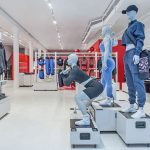Big 5 Sporting Goods Corp reported a sharp drop in first-quarter earnings on lower margins and a 2.9 percent comp decline. The chain blamed the shortfall on continued macroeconomic weakness in its Western U.S. market, and the absence of winter weather across the vast majority of geographies that significantly reduced demand for cold weather products.
Earnings came to $156,000, or 1 cent a share, down from $2.76 million, or 13 cents, a year ago. Revenues slid 1.2 percent, to $218.5 million.
Gross margins eroded to 30.9 percent versus 32.6 percent in the first quarter of the prior year. Merchandise margins were down 156 basis points reflecting the product sales mix shift away from higher margin winter-related products due to unfavorable winter weather conditions, as well as increased promotional activities, including efforts to sell winter products later in the quarter, and product cost inflation. SG&A expenses increased to 30.5 percent of sales from 30.4 percent as a reduction in employee benefit-related costs from higher than normal levels in the prior year period, as well as a reduction in debit card fees as a result of recent federal legislation offset the impact of lower revenues.
On a conference call with analysts, Steve Miller, Big 5's president and CEO, said sales of sales of winter-related products fell 25 percent for the quarter. The chain was particularly impacted during the first two weeks of the quarter following New Year's and over the period surrounding President's Day, which are historically key winter product selling periods. The mild weather particularly impacted apparel, which comped down low double-digits for the quarter. Footwear and hard good categories were slightly negative. Excluding sales of winter-related products, same-store sales for the quarter were positive, in the low single-digit range with non-winter products generally performing well.
Traffic saw a low mid single-digit decrease but average ticket grew low single-digits.
Per-store inventories were up 1.8 percent from the prior year but were down from the prior year at quarter-end excluding winter products. Currently, per-store inventories are virtually flat with the prior year, including winter product carryover. Added Miller, “We obviously have more than normal carryover of winter product, and our plan is to buy judiciously around this mix of product for next year's winter season.”
On the positive side, Miller said cited the early strong consumer response to efforts to selectively downsize certain underperforming product lines while expanding some showing strength. Miller described the merchandise changes as “pretty broad-based.” He elaborated, “”The new products cover the gamut of all of our major merchandise categories, hard goods, footwear, and apparel. A little more focus and in certain cases of more branded product, in some cases its expanding, size and color runs. In other cases it is reaching out to some higher price points in an effort to appeal to a consumer who may have more discretionary income in today's environment.”
Big 5 is also seeing positive results from the expansion of its digital marketing efforts.
Looking ahead, same-store sales for the second quarter to date are up in the positive low single-digit range. Although merchandise margins are still running down, they've improved for each month since January. Miller added, “Our April customer traffic comparisons to the prior year are the best that we have experienced since last October, and we have seen accelerating improvement in average ticket comparisons to the prior year for each month since January.”















